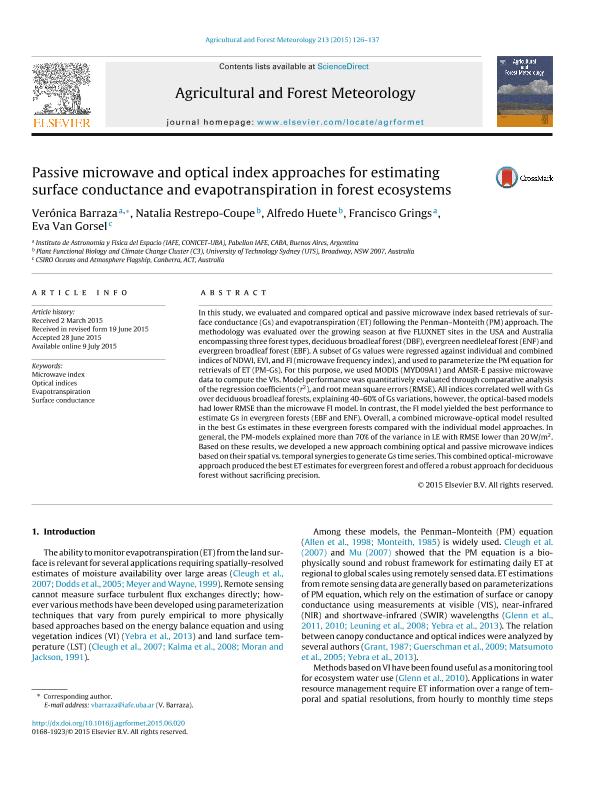Artículo
Passive microwave and optical Index approaches for estimating surface conductance and evapotranspiration in forest ecosystems
Barraza Bernadas, Verónica Daniela ; Restrepo Coupe, Natalia; Huete, Alfredo; Grings, Francisco Matias
; Restrepo Coupe, Natalia; Huete, Alfredo; Grings, Francisco Matias ; Van Gorsel, Eva
; Van Gorsel, Eva
 ; Restrepo Coupe, Natalia; Huete, Alfredo; Grings, Francisco Matias
; Restrepo Coupe, Natalia; Huete, Alfredo; Grings, Francisco Matias ; Van Gorsel, Eva
; Van Gorsel, Eva
Fecha de publicación:
11/2015
Editorial:
Elsevier Science
Revista:
Agricultural And Forest Meteorology
ISSN:
0168-1923
Idioma:
Inglés
Tipo de recurso:
Artículo publicado
Clasificación temática:
Resumen
In this study, we evaluated and compared optical and passive microwave index based retrievals of surface conductance (Gs) and evapotranspiration (ET) following the Penman-Monteith (PM) approach. The methodology was evaluated over the growing season at five FLUXNET sites in the USA and Australia encompassing three forest types, deciduous broadleaf forest (DBF), evergreen needleleaf forest (ENF) and evergreen broadleaf forest (EBF). A subset of Gs values were regressed against individual and combined indices of NDWI, EVI, and FI (microwave frequency index), and used to parameterize the PM equation for retrievals of ET (PM-Gs). For this purpose, we used MODIS (MYD09A1) and AMSR-E passive microwave data to compute the VIs. Model performance was quantitatively evaluated through comparative analysis of the regression coefficients (r2), and root mean square errors (RMSE). All indices correlated well with Gs over deciduous broadleaf forests, explaining 40-60% of Gs variations, however, the optical-based models had lower RMSE than the microwave FI model. In contrast, the FI model yielded the best performance to estimate Gs in evergreen forests (EBF and ENF). Overall, a combined microwave- optical model resulted in the best Gs estimates in these evergreen forests compared with the individual model approaches. In general, the PM-models explained more than 70% of the variance in LE with RMSE lower than 20 W/m2. Based on these results, we developed a new approach combining optical and passive microwave indices based on their spatial vs. temporal synergies to generate Gs time series. This combined optical-microwave approach produced the best ET estimates for evergreen forest and offered a robust approach for deciduous forest without sacrificing precision.
Palabras clave:
Surface Conductance
,
Evapotranspiration
,
Microwave
,
Optical
Archivos asociados
Licencia
Identificadores
Colecciones
Articulos(IAFE)
Articulos de INST.DE ASTRONOMIA Y FISICA DEL ESPACIO(I)
Articulos de INST.DE ASTRONOMIA Y FISICA DEL ESPACIO(I)
Citación
Barraza Bernadas, Verónica Daniela; Restrepo Coupe, Natalia; Huete, Alfredo; Grings, Francisco Matias; Van Gorsel, Eva; Passive microwave and optical Index approaches for estimating surface conductance and evapotranspiration in forest ecosystems; Elsevier Science; Agricultural And Forest Meteorology; 213; 11-2015; 126-137
Compartir



